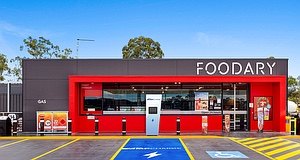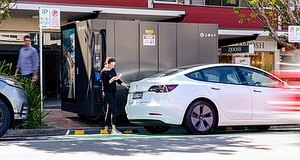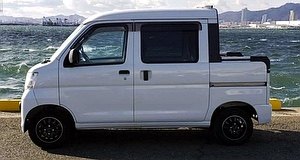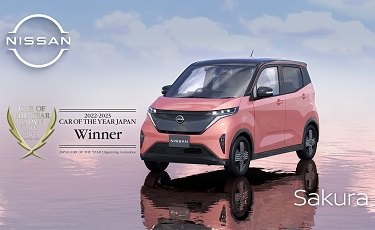- 53,969

- Australia
Came across this channel
It‘s like Back to the Future hover conversions. I’m digging this.
It‘s like Back to the Future hover conversions. I’m digging this.


Volvo Trucks Australia has just announced sales start of the all-electric medium duty truck range for Australian transport operators.


Been thinking about this a lot lately and I think BEVs with enough range to be "all purpose" are a tremendous waste of resources, in most cases. Looking over some transportation statistics data, about 78% of all commutes in the US are 40 miles or less. In 2017, nearly 60% of all vehicle trips were less than 6 miles. It truly strains reason to think bringing 100kwh of battery (at 0.15kwh/kg!) with you for these short distances is a good idea. The amount of energy wasted just moving the weight of the batteries must be non-trivial. Of course the king of the absurdity, as always, is the Hummer with it's 212kwh battery weighing more than my entire Boxster, at 2923 lbs.
Until there is some quite substantial advancement in battery tech, I don't think long range BEVs are a particularly good use of resources when PHEVs exist. If you are driving less than 40 miles a day, on average, then you only need like 15-30kwh of battery. If you need to drive further than that, then you have the fuel engine to get you there but the amount of lithium being wasted on these massive batteries that probably rarely get used to full capacity is kind of crazy. Now if you have a 100 mile commute every day (or other reason for driving big distances often) then a big battery EV could make sense, but for the vast majority of commuters a PHEV is both cheaper and, on balance, probably better for the environment if they are widely adopted. The problem is that BEVs are getting all of the attention and all of the resources (citation needed, but it feels right) whereas PHEVs could solve more problems faster, IMO.*
*If less battery material is being used for big ass long range EVs that are rarely used to their range limits, then theoretically there is more battery material available to be utilized in PHEVs which means that more miles are being driven on battery power. And make no mistake, there are supply constraints at the moment.
Practical example:
1x Hummer BEV: 212kwh battery - Range 329 miles
vs
15x Hyundai Tucscon PHEV : 13.8kwh battery - EV Range 33 miles
Those 15 Tucscons have abstractly the same amount of battery as a single Hummer EV. The Hummer goes 10 times further than each of the Tucscons (why it doesn't go 15x further is another question...), but as demonstrated above a 329 mile trip would be a rare event. So you have about 200kwh of battery that is just sitting there, unused most of the time. Lets look at it from the perspective of a daily 30 mile commute:
The Hummer delivers 30 miles of battery-powered driving per commute
But if you used that battery material for the Tucsons instead, you're getting 450 miles of battery-powered driving. It's just a far more efficient use of resources. **
The question, I think, should be: How can we get the most amount of MILES DRIVEN (not theoretical miles of range) from each KG of lithium mined? At the moment, I think it's pretty obvious that right-sized-battery PHEVs is the clear winner if all the context is taken into consideration.
**You could make the same argument for something like a Nissan Leaf or Mazda MX-30 but the issue with those is adoption and range anxiety. People want a car they could drive long distances in, regardless of how often that actually happens. Ultimately, if EVs are to be successful broadly, they actually have to be adopted. This has always been the problem with short range BEVs.
Ay-oh!(we could call them EIUs)
I'm using lithium as a stand-in for all the materials used in a lithium-ion battery.Why are you picking kg of lithium mined as your particular metric? If you were to look at kWh used on a 30 mile commute, I think you would probably find that the Tucson outperforms the Hummer there as well, but the cost of the kWh difference is probably quite low, as is (likely) the environmental impact.
If lithium mined, or kWh for that matter, is our metric, ICE cars are the best option since they come in at zero in both cases. If we're judging by carbon, I'm not sure kg of lithium mined is particularly high either. I think you're looking for some other kind of ecological impact units (we could call them EIUs).
Corporate image more than anything else.The problem is that BEVs are getting all of the attention and all of the resources (citation needed, but it feels right) whereas PHEVs could solve more problems faster, IMO.
Cynicism aside, I don't think people perceive an engine that isn't running as an inherently bad thing - at least not to the degree you are implying. The problem is that people also don't perceive 500kg of unused battery as a bad thing, when its arguably more wasteful. I think PHEVs need better marketing. I think most people associate them with normal hybrids, which to be fair they kind of are, but they are significantly better than normal hybrids.Corporate image more than anything else.
It's a business suicide nowadays to build a car that has a ~150 kg lump of iron and aluminium (both of which are extremely well recyclable) in it but that will only be used perhaps once a month, for the rest of the time it's just dead weight. The public opinion of such a thing is pretty much comparable to pouring waste oil into a river while burning old tyres on the bank. That thing IS BURNING DINOSAURS AND KILLING US ALL! Even if it was running on bioethanol.
At the same time building a car that has a ~500 kg lump of lithium, cobolt and other rare metals (none of which are properly recyclable) that will also only be used perhaps once a month and for the rest of the time it's dead weight, is so green that #00FF00 looks like dark grey next to it. All the machinery and factories used to mine and refine those metals are letting only flower smell out of the exhausts and chimneys.
There might be another solution in swappable batteries. Use a light, low capacity battery for normal trips and have a big high capacity battery for long range travel (or perhaps not at all if you don't think you'll need it). The idea has already been considered for eliminating charge times (at least from the vehicle operator's perspective). Although I admit fiddling with multiple hundred or thousand pound pieces of equipment isn't the most practical thing for the average person to handle in their garage.The question, I think, should be: How can we get the most amount of MILES DRIVEN (not theoretical miles of range) from each KG of lithium mined? At the moment, I think it's pretty obvious that right-sized-battery PHEVs is the clear winner if all the context is taken into consideration.
This isn't a bad idea, but as you say the logistics get tricky. Didn't Tesla nominally have battery changing stations that weren't actually functional? I wonder how good kinetic energy storage could theoretically get. Seems like the current state of the art vacuum-sealed, maglev carbon fiber flywheel storage systems (not designed for automotive use) are roughly 2" long / kwh of storage, meaning a 50kwh (the threshold of "good enough storage for automotive applications, especially considering the faster "charging" speed) flywheel would be about 8.5' long and around 5' in diameter. That's big, but not orders of magnitude too big. If this tech had the same level of investment, could those dimensions shrink to 2.5' x 4'? That's around the size of a V12 - and smaller and likely significantly lighter than an EV battery. There are some dynamic issues I suppose, but maybe the gyroscopic forces could be used in place of anti-roll bars? Such devices are used to stabilize ships. The benefits over a battery are huge - far simpler to manufacturer, a lot less exotic materials, and a near limitless lifespan.There might be another solution in swappable batteries. Use a light, low capacity battery for normal trips and have a big high capacity battery for long range travel (or perhaps not at all if you don't think you'll need it). The idea has already been considered for eliminating charge times (at least from the vehicle operator's perspective). Although I admit fiddling with multiple hundred or thousand pound pieces of equipment isn't the most practical thing for the average person to handle in their garage.
Large batteries could be rentals that are installed at charge stations/dealerships only when needed, and making them a shared resource should cut down on the number needed, but I don't know if people would find that too inconvenient.
I just realized I never actually came back to this.I'm using lithium as a stand-in for all the materials used in a lithium-ion battery.
Miles driven per KG of lithium mined seems like a pretty good metric to suss out the resource efficiency of electric cars as a whole. ICE cars obviously beat battery cars in this metric, but the point is we WANT miles to be driven on lithium batteries (at least until there is a better alternative) - as many miles as that lithium can provide. We don't want literal tons of lithium sitting in big batteries which rarely get used to their full capacity if that lithium can be better utilized elsewhere. Lithium is a finite resource (ignoring recycling for now). I'm going to make up an example to illustrate what I'm trying to get at.
Imagine there is 1000kg of lithium on earth and you have three options:
Build 1 hummer EV with a 215kwh battery
Build 15 Tucson PHEVs with 15kwh batteries
Build 15 Generic BEVs with 15kwh batteries
Assuming the same typical 30 mile commute every day, it's pretty easy to see that the 15 Tucscons will achieve greater total miles driven than the single hummer. Over the course of it's useful lifetime, that 1000kg of lithium will probably deliver something on the order of 1 million miles driven (30 miles a day, 5 days a week, 10 years) when it's used in batteries of the Tucsons. If it's used in the Hummer instead, it will be less than 100,000 under the same criteria. The Generic BEV would achieve the same result as the Tucson and is theoretically as efficient at converting Lithium to miles driven, but people would probably not buy them because their total range would be under 50 miles or so.
The actual energy produced to charge the batteries is a totally different subject.
Full disclosure: I'm actually trying to buy a Hyundai Tucscon PHEV at the moment. The problem is that Hyundai & Kia are prioritizing building their BEV cars that have much larger batteries and so they are simply not available - I've been waiting months to get an allocation. I find this both annoying personally and from an environmental perspective because if I could take a 15kwh chunk off of somebody's Ioniq5 they very likely wouldn't notice it because most people only drive 40 miles a day or less. So somebody's else's 62kwh of surplus capacity in battery size is preventing the sale of a more modest PHEV to somebody who would like to drive carbon free.
Because making batteries (that do not have unlimited lifespans and are not easily recyclable, mind you) with mined, none-infinite rare earth elements should be thoughtfully done. I'll make an even more extreme example because evidently my Hummer example is not hitting home. Just imagine humanity mined up every last bit of nickel cobalt lithium iridium etc and just jettisoned all of it from earth into the sun. That would be a bad way to use those resources. Using them to instead make a big ass battery for a Hummer is better. Using them to make a bunch of batteries for smaller BEVs or PHEVs is, in my opinion, better still.I just realized I never actually came back to this.
I'm still not sure why you care so focused on miles per kg of lithium. I realize that the energy to charge the batteries is a different subject, but typically it is that subject that is the focus of environmental efforts. So I'm asking you why the change of subject to miles per kg lithium. I understand the importance of one metric (mile per energy), I don't understand the importance you're placing on the other metric (miles per kg lithium).
As far as I know, the problem you're highlighting is being attacked on many fronts - including finding more efficient ways to use lithium, better mining, better recycling programs, and alternatives to lithium for batteries. Conservation happens automatically in response to price. So all you need to bring your dream of more efficient use of lithium to bear is a price increase, which does appear to be in the future. That will allow for a gradual market shift toward more cost effective solutions.Because making batteries (that do not have unlimited lifespans and are not easily recyclable, mind you) with mined, none-infinite rare earth elements should be thoughtfully done. I'll make an even more extreme example because evidently my Hummer example is not hitting home. Just imagine humanity mined up every last bit of nickel cobalt lithium iridium etc and just jettisoned all of it from earth into the sun. That would be a bad way to use those resources. Using them to instead make a big ass battery for a Hummer is better. Using them to make a bunch of batteries for smaller BEVs or PHEVs is, in my opinion, better still.
Again, there are real supply and production constraints to producing batteries and environmental cost. Is it better to get more batteries into the hands of more people, or bigger batteries into the hands of fewer people? All else being equal, I think the latter is ultimately better for the environment and climate. You get those materials offsetting more carbon based fuels more quickly.
I think the easier route would be some kind of car rental program.There might be another solution in swappable batteries. Use a light, low capacity battery for normal trips and have a big high capacity battery for long range travel (or perhaps not at all if you don't think you'll need it). The idea has already been considered for eliminating charge times (at least from the vehicle operator's perspective). Although I admit fiddling with multiple hundred or thousand pound pieces of equipment isn't the most practical thing for the average person to handle in their garage.
Large batteries could be rentals that are installed at charge stations/dealerships only when needed, and making them a shared resource should cut down on the number needed, but I don't know if people would find that too inconvenient.
If we went down that route cars themselves should be rentals ideally, not just ones for long trips (not sure if you meant rentals in place of battery swaps or rentals in place of car ownership). If people had their own cars and rentals for long distances, that would lead to more cars overall, rather than just batteries. At that point we might as well focus on mass transit.I think the easier route would be some kind of car rental program.
Ok I'm gonna try to bring this back to the real world. Per Changeit, the C02 cost of constructing lithium batteries is 73kg of C02 per KWH of battery. Now we can use that and go back to my example of the Hummer & Tucson, with the same assumptions as before:As far as I know, the problem you're highlighting is being attacked on many fronts - including finding more efficient ways to use lithium, better mining, better recycling programs, and alternatives to lithium for batteries. Conservation happens automatically in response to price. So all you need to bring your dream of more efficient use of lithium to bear is a price increase, which does appear to be in the future. That will allow for a gradual market shift toward more cost effective solutions.
I'm not sure that lacking the big sexy batteries of the BEVs ends up offsetting more carbon-based fuels. You might be able to make more efficient use of lithium with hybrid approaches, but there are downsides, including complexity and maintenance. Plus, it's just not as big and powerful and cool. People want to be able to step on it, warp to plaid, and not run out of juice. That kind of thing does help get people off of carbon-based fuels.
Anyway, I continue to question your metric here.
Because they do not produce tailpipe emissions, electric cars are less polluting than otherwise identical gas-powered models. But EVs still create emissions in other ways, notably from the electricity required to build them and charge their batteries. Such energy needs rise dramatically for the biggest cars: According to the American Council for an Energy-Efficient Economy, the 9,063-pound GMC Hummer EV contributes more emissions per mile than a gas-powered Chevrolet Malibu.
Worse yet, enormous EVs are compounding the global shortage of essential battery minerals such as cobalt, lithium, and nickel. That Hummer EV’s battery weighs as much as a Honda Civic, consuming precious material that could otherwise be used to build several electric-sedan batteries—or a few hundred e-bike batteries. One recent study found that electrifying SUVs could actually increase emissions by restricting the batteries available for smaller electric cars.
In the United States, fewer than 5 percent of trips are longer than 30 miles. For a gas engine, that represents a portion of a fuel tank. For an EV, range is the result of a more complicated set of decisions about how to best use expensive, hard-to-obtain metals. Melin, an expert in battery recycling, is often asked by governments and automakers how those resources can be stretched. It would be nice if he could tell them that recycling materials from old batteries would do the job. But it can’t. Batteries can power cars for a decade or more, and with EV adoption and the size of the average vehicle increasing every year, old batteries can contribute only so much. So Melin’s suggestion: Start off with less. Use smaller batteries in the first place.

Probably too soon to go big. Hybrids & EVs we’re doing fine as econoboxes and/or mass transit. The Lightning, as an example, is definitely cool, but it’s become a size race, rather than the old V8 power wars.My humble opinion is that if we want less pollution, we should also be focusing on smart resource usage. These electric cars shouldn't be sitting in the dump in 10 years.
I'm also not on the all electric wagon. I think it's too soon.
I don't mind the BEV at all. But I agree with you that PHEVs are currently amazing, and the toyota offerings are especially tempting. Electricity consumption is a funny thing these days, because so many people are generating it themselves. If someone buys a hummer BEV, how often are they driving it? How much of the electricity is coming from their roof? The emissions calculation is not so easy, but it is fair to say that per mile if you charge it form the grid you can get worse emissions than other, significantly different, ICE cars.Or, better yet, PHEVs that are basically both of those vehicles in one.
So Toyota isn’t anti-EV, but it believes in a diversified approach and it’s predicting a global shortage of lithium, which is the most important material used in today’s lithium-ion batteries found in pure EVs, hybrids, and plug-in hybrids.
Gill Pratt and his team concluded that to lower carbon emissions as much as possible, it makes more sense to spread the limited supply of lithium among as many cars as possible, electrifying as many cars as possible.
He hypothesized a fleet of 100 internal combustion engine cars with average emissions of 250 grams of carbon dioxide per kilometer traveled. Now, assuming a limited supply of lithium, there’s only enough of it to make 100 kilowatt-hours of batteries. Toyota’s Chief Scientist says that if it were used for a single, big battery, the average emissions of the whole fleet would drop by just 1.5 g/km.
But if the small amount of lithium were spread among smaller, 1.1-kWh batteries, it would be possible to make 90 hybrid cars, which would still leave 10 traditional combustion cars, but the average emissions of the theoretical fleet would drop to a much lower 205 g/km.
It’s a counterintuitive idea, that a big fleet of hybrids would make a bigger positive impact on emissions than a smaller fleet of EVs, and Toyota says this nuance is lost in the talks about adopting EVs on a global scale. Pratt also criticized rival car companies’ ambitions, calling them “happy talk” and saying that their forward-looking statements usually have an asterisk that says “if conditions permit”.